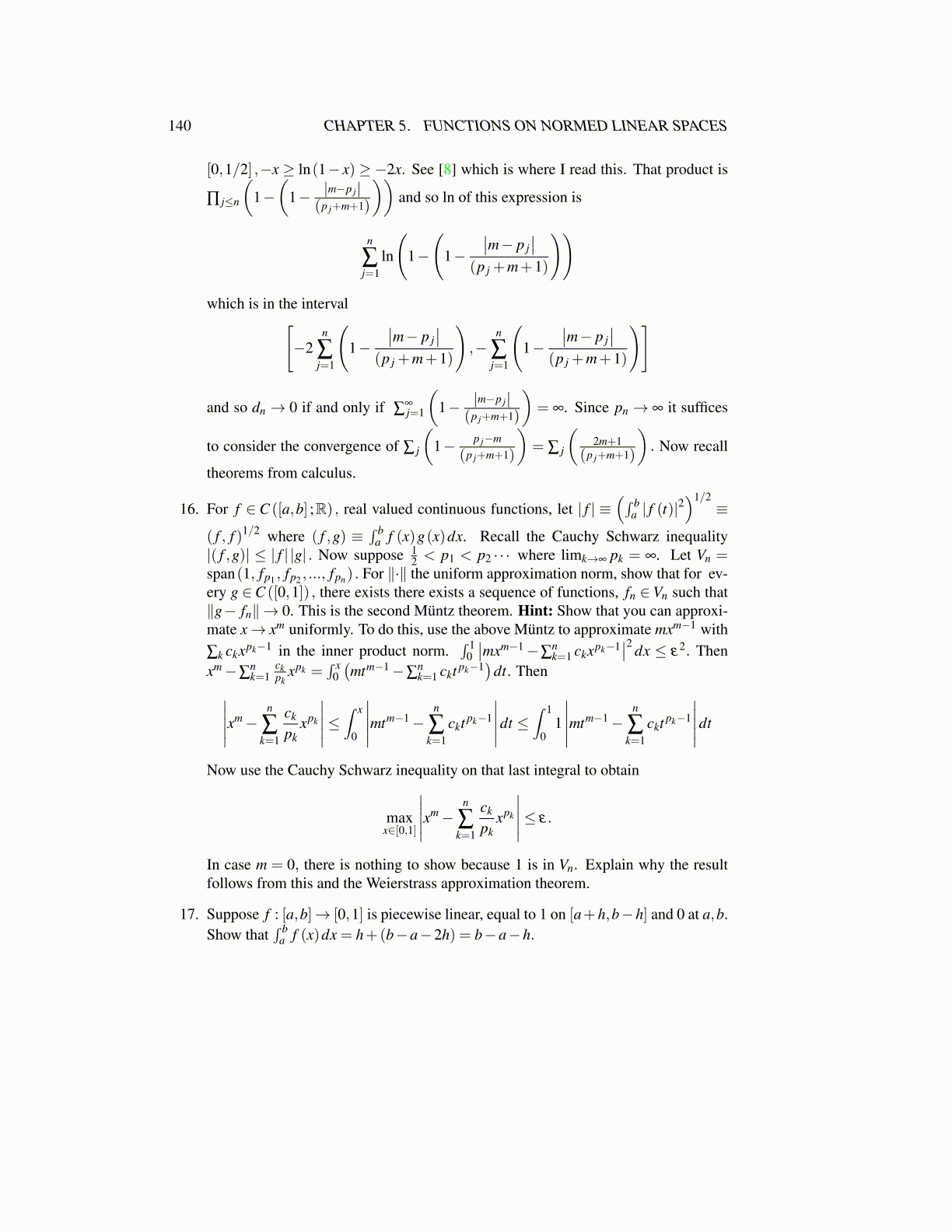
140 CHAPTER 5. FUNCTIONS ON NORMED LINEAR SPACES
[0,1/2] ,−x ≥ ln(1− x) ≥ −2x. See [8] which is where I read this. That product is
∏ j≤n
(1−(
1− |m−p j|(p j+m+1)
))and so ln of this expression is
n
∑j=1
ln
(1−
(1−
∣∣m− p j∣∣
(p j +m+1)
))
which is in the interval[−2
n
∑j=1
(1−
∣∣m− p j∣∣
(p j +m+1)
),−
n
∑j=1
(1−
∣∣m− p j∣∣
(p j +m+1)
)]
and so dn → 0 if and only if ∑∞j=1
(1− |m−p j|
(p j+m+1)
)= ∞. Since pn → ∞ it suffices
to consider the convergence of ∑ j
(1− p j−m
(p j+m+1)
)= ∑ j
(2m+1
(p j+m+1)
). Now recall
theorems from calculus.
16. For f ∈ C ([a,b] ;R) , real valued continuous functions, let | f | ≡(∫ b
a | f (t)|2)1/2
≡
( f , f )1/2 where ( f ,g) ≡∫ b
a f (x)g(x)dx. Recall the Cauchy Schwarz inequality|( f ,g)| ≤ | f | |g| . Now suppose 1
2 < p1 < p2 · · · where limk→∞ pk = ∞. Let Vn =span(1, fp1 , fp2 , ..., fpn) . For ∥·∥ the uniform approximation norm, show that for ev-ery g ∈C ([0,1]) , there exists there exists a sequence of functions, fn ∈Vn such that∥g− fn∥→ 0. This is the second Müntz theorem. Hint: Show that you can approxi-mate x→ xm uniformly. To do this, use the above Müntz to approximate mxm−1 with∑k ckxpk−1 in the inner product norm.
∫ 10
∣∣mxm−1−∑nk=1 ckxpk−1
∣∣2 dx ≤ ε2. Thenxm−∑
nk=1
ckpk
xpk =∫ x
0(mtm−1−∑
nk=1 ckt pk−1
)dt. Then∣∣∣∣∣xm−
n
∑k=1
ck
pkxpk
∣∣∣∣∣≤∫ x
0
∣∣∣∣∣mtm−1−n
∑k=1
ckt pk−1
∣∣∣∣∣dt ≤∫ 1
01
∣∣∣∣∣mtm−1−n
∑k=1
ckt pk−1
∣∣∣∣∣dt
Now use the Cauchy Schwarz inequality on that last integral to obtain
maxx∈[0,1]
∣∣∣∣∣xm−n
∑k=1
ck
pkxpk
∣∣∣∣∣≤ ε.
In case m = 0, there is nothing to show because 1 is in Vn. Explain why the resultfollows from this and the Weierstrass approximation theorem.
17. Suppose f : [a,b]→ [0,1] is piecewise linear, equal to 1 on [a+h,b−h] and 0 at a,b.Show that
∫ ba f (x)dx = h+(b−a−2h) = b−a−h.